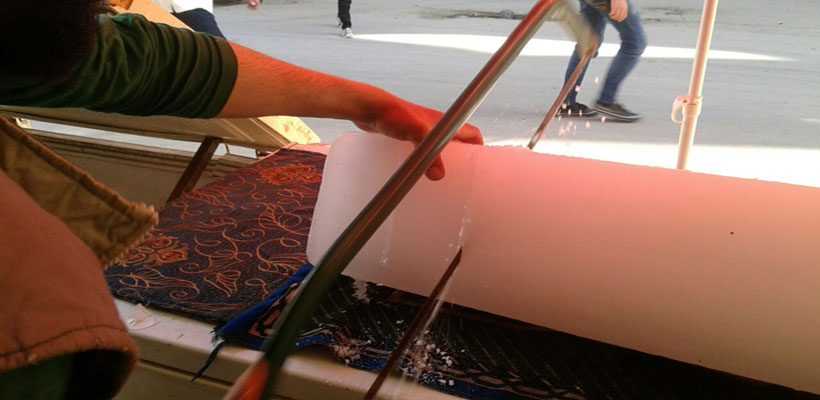With no refrigeration or electricity, East Ghouta residents who can afford it use ice to preserve food
In the besieged, rebel-held east Damascus suburbs, drinking a cold […]
11 July 2017
In the besieged, rebel-held east Damascus suburbs, drinking a cold glass of water is a “luxury,” says one local resident.
As Syria passes through the hottest days of the year, it’s been nearly four years since the encircled enclave of East Ghouta, just east of Damascus, has had consistent access to electricity.
To fight the heat, residents rely on ice to keep food from spoiling. On Tuesday, temperatures in East Ghouta’s Douma city reached 106 degrees Fahrenheit.
“There is no other way to keep goods cold,” Abu Ahmad, a resident of Hamouria city in East Ghouta, tells Syria Direct’s Noura al-Hourani.
Using diesel-powered refrigeration equipment, workers make blocks of ice sold by the kilogram, says Abu Ahmad. But it’s expensive, and few can afford it.
“We have to buy food every day, in quantities for one meal only, so that nothing is left over that needs to be refrigerated.”
Q: You mentioned that you use ice to keep drinking water cold. What about food and meat?
Most people are unable to buy ice because they can’t afford it.
Drinking a glass of cold water has become a luxury for people here.
We have to buy food every day, in quantities for one meal only, so that nothing is left over that needs to be refrigerated.
Most homes in East Ghouta don’t keep meat and milk and other similar products, since they can’t keep them in refrigerators and iceboxes.
People dry their food instead of freezing it, or preserve it in concentrated salt water, a process similar to pickling.

Q: Is it difficult to get ice? How does someone in East Ghouta find it?
There are a number of shops that produce ice throughout East Ghouta, and smaller centers and stalls that sell ice in every neighborhood.
The most pressing issues with ice include the increased demand with the high summer heat, and the distance of ice manufacturers from residents’ homes. You have to buy ice from the place nearest to your home so it doesn’t melt by the time you get back.
It’s also important for people to try and get clean ice. Most of the ice is made from water extracted from calcified wells.
[Manufactureres] pour water [from these wells] and freeze it using metal molds that are sometimes rusty, and then cut them using iron saws that are also sometimes rusty.This process causes a number of different illnesses, including intestinal infections, fever, and diarrhea—especially among young children.
In central East Ghouta, we haven’t seen any kind of regulation—no one is paying attention.
Nevertheless, in this heat people have to buy ice. In the winter, you can wear more clothes to warm yourself, but with the heat you can’t do anything without electricity. [Heat and cold] kill Syrians every year.
Q: Why isn’t water purified? How do people protect themselves when using ice?
There are a number of water filtration and purification places in East Ghouta, however they are not able to provide enough purified water to ice producers.
After noticing the spread of disease caused by using this ice, people began putting ice in nylon bags [in order to avoid direct contact with food or drink.]
However, this cannot be done in restaurants or ice cream and juice stands.







